They Are Stealing Our Work |
1 An example of a university stealing my work
In January 2011 I was alerted to an unauthorized use of my work by Alvenia University. The way this 'alert' took place was weird. An Alvenia teacher called me to ask me how much it would cost to licence my work. I explained that the cost was based on usage, that my minimum fee was $250, and that this would cover minimum usage such as a single use in a newletter for example. The teacher answered that this was way beyond their budget. I asked which image she was interested in and she answered it was Playa Reflections and that a student had won a contest for a poster design featuring my image. She then hung up.
Surprised at this news I googled Alvenia and within seconds I was looking at the poster that the teacher mentioned to me. This poster, which you can see below, not only featured my image but was a full advertising for a conference featured by Alvenia University. Not only that, but the poster was already used to advertise this conference, being used as header on the conference's web page on Alvenia's website.
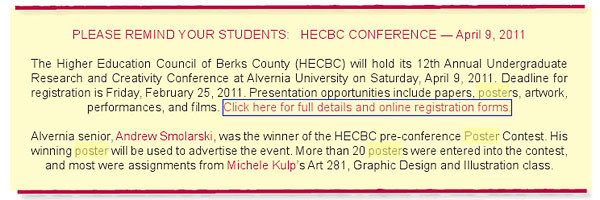
The HECBC conference poster-contest winner announcement
The winner is the person who used my photograph without my permission.
I called back the university, using the number on their website, to request immediate payment since my image was being used for a commercial purpose. I also followed through with an email. I never received payment, in fact the response I got over the phone (I talked to the person who was in charge of organizing this conference) was surprise at the fact that I wanted money as retribution for the use of my work. Furthermore, it took nearly a week for my photograph, and the poster, to be removed from Alvenia's website.
What's shocking is that the teacher who supervised this contest did not see anything wrong with this. She did not teach her students about copyright law, and did not tell them to ask the copyright holder for permission. When she called me she seemed surprised to learn that use of copyrighted work is subject to terms defined by the copyright holder.
Finally, the contest winner cloned out the copyright logo (© Alain Briot) that I type onto each of my web photographs. This action demonstrates a definite intent to hide who holds the copyright to this image.
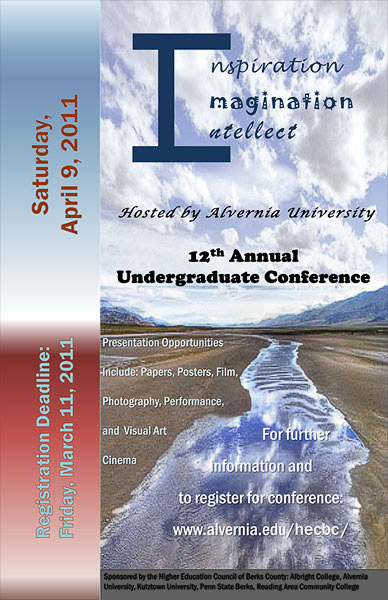
The poster showing the unauthorized use of my photograph, Playa Reflections,
by Alvenia University
2 Facebook
Social media works great when it comes to this kind of issue. While it may not solve the problem, sharing your misfortune publicly provides a measure of relief. Below is a screenshot of the facebook conversation that followed my post about the infringement:
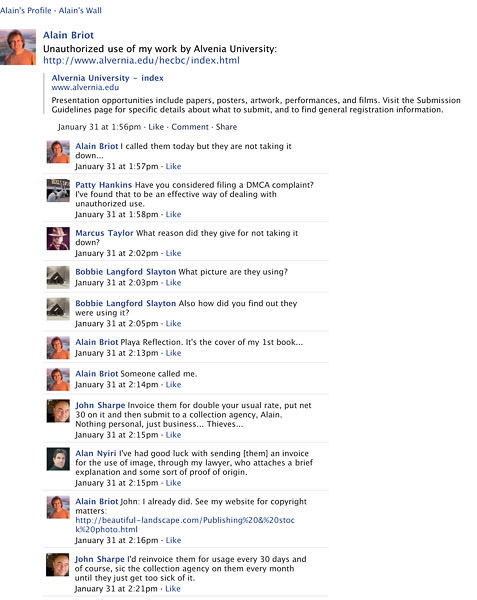
3 - It can, and will, happen to anyone
Eventually this can happen to any of us, known or unknown. I don't think how known one is has much to do with it. It's more how much exposure a photo has, meaning how widely it is found on the web that defines whether it will be stolen or not. Then it's the content, the appeal of the image. The reason why mine was stolen is because of its metaphorical content, because of the fact that it showed, metaphorically, a path towards a distant horizon, a theme that echoed the theme of the conference it was used to advertise, at my cost!
I think this is going to happen more and more with the internet becoming the primary form of communication and advertising. It's just too easy and it's very difficult to track. Even when you get them to stop, you don't get any money, you just waste time. Nobody wins. That's the main problem. A simple and effective solution is needed. Which one? I don't have a clue. Copyright legislation is supposed to take care of this, unfortunately as we all know it does not work.

Playa Reflections is the cover image of my first book
4 - Copy is a fine compliment
Some say that being copied is the finest form of compliment. Perhaps. Actually, not really. And if you ask me, not at all. In fact, it simply s***s. There's no money in it, and while it does bring you some attention, it is not the kind of attention I am looking for.
5 What can we do ?
So what can we do? Well, there's a lot of things we can do. In the sections below I outlined the different types of actions you can take to address this issue.
6 - Prevention
An ounce of prevention is better than a pound of cure or so the saying goes. It's also cheaper in most instances. Here are a several ways you can prevent illegal use of your work:
A Use web image tracking software
Examples of web tracking software:
- Digimarc: www.digimarc.com
- Image recognition software:
- PicScout: www.picscout.com
- Other:
B Put a copyright notice on all your web images
Personally I type "© AlainBriot.com" in Photoshop, on all my web images. This achieves several things:
- It gives to all viewers the name of the author
- It gives my website address
- It shows who is the copyright owner of the work
- It is quick and simple to do
- If someone erases this text, it proves an additional level of criminal use
- It is not unsightly and does not detract viewers from enjoying the images
C Enter your name and other personal information in the image metadata
- You can do that in most raw converters and in Photoshop - Problem is that converting the image to jpeg usually deleted most of this information. - Plus thieves don't care if your name is in the metadata or not - It won't stop image theft but it will make it easier to prove the photo is yours
D Keep all your web images to 600 pixels maximum width or height
Keeping web images small means that if they are stolen, their use is very limited. In fact, besides web use and small illustrations, there's very little that can be done with such small images.
E Come to terms with web reality
The minute you put an image on the web, you lose control of who is going to get it. Regardless of how many notices, statements or warnings you may have on your website, there is nothing to stop someone from downloading your work to their computer. Whether they use it illegally or not is another matter, but for sure your work will be downloaded by some, if not by many, viewers. Using flash or a transparent layer over the image works only in regards to preventing theft done by dragging your image to their desktop. However, it does not prevent the viewer from doing a screenshot (Command 3 or 4 on a Mac) and making a copy of your images that way. On a color-calibrated monitor, the quality is just as good downloading the image.
7 - Do nothing
Certainly, you can do nothing. But for me that's not an option. The minute I learn that someone is using my work illegally, I have to do something. However, my way is not the only way, so you may want to 'let it be.' If it doesn't bother you, if you sleep just as well after hearing about it as you did before, then why not.
8 Take care of the matter yourself
Ask to be paid for the use of your work. That's the most obvious request, unfortunately it is hardly ever agreed to by the infringer. Why? Because if they were OK paying you for the use of your work, they would have called you to inquire about your rate and paid you before using your photographs!
Ask the infringer to cease and desist, either by phone, email or physical letter. Letter is best but email and phone are faster. Start with phone, to get through to them immediately, and follow with email to have something tangible and in writing. If you want to go all the way, send a letter as well.
If you are OK with letting the image being used for free, ask for image credit instead of money.
9 Hire a lawyer
You may want to hire a lawyer to help you file a copyright lawsuit. The only thing is that it will cost money. Lawyers work for money and their hourly rate is high. The cost is worth it, but only if it brings you more money than you spend. In other words, approach this as a business and calculate your potential profit. I know this can be challenging because you won't know ahead of time exactly how much you will get after litigation is completed, but you can at the very least find out if there is any money to be made.
Of course, you may want to litigate out of principle, in other words, because you find satisfaction in proving your point in court, regardless whether you make or lose money doing so. A friend of mine received a $500 fine after being caught speeding by a traffic camera. He hired a lawyer who charged him $500 to get the ticket cancelled. I mentioned to him that this doubled the cost of his ticket. He answered that first, the money went to his lawyer and not to the state, and second that it was a matter of principle (he argued in court that he was not driving his car and that because the ticket was issued by a camera, not by an officer, no one had seen him physically in the car), not of money.
10 Embrace the Creative Commons approach
A different way of looking at this problem is to use the Creative Commons approach. Instead of sending take down notices to those who use your work without your permission, follow the creative commons approach and give your work away for free to non-commercial users. This means that people interested in using your work for illustration purposes, but without trying to sell anything, get to use your work at no cost. Instead of money, they provide you with a link to your site and possibly with free advertising for your services. People who want to use your photographs to sell a product do have to pay for this use.
While this approach is not for everyone, it makes sense for those who are willing to explore new possibilities. Whether it is for you or not is something you have to decide for yourself. You will make new fans in the process, and it may work if used in the context of an adequate marketing approach.
The Creative Commons recently launched a publication titled The Power of Open that provides an overview of the licenses and shares stories of artists who found success through CC licensing. Here is their web address: www.thepowerofopen.org.
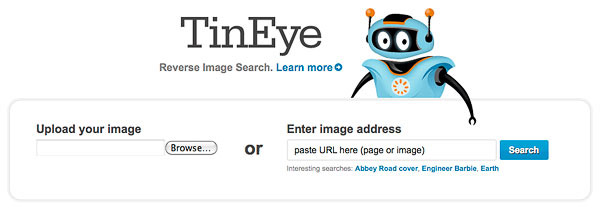
11 Use Image Tracking
Several websites and software are availble to help you track your photographs. The problem is that you have to track each photograph individually. This can take a huge amount of time if, like me, you have an extensive image library. The solution is to track only those images that are most likely to be stolen such as your best sellers, book covers, and other images that you know to be popular.
The website I use the most is www.tineye.com:
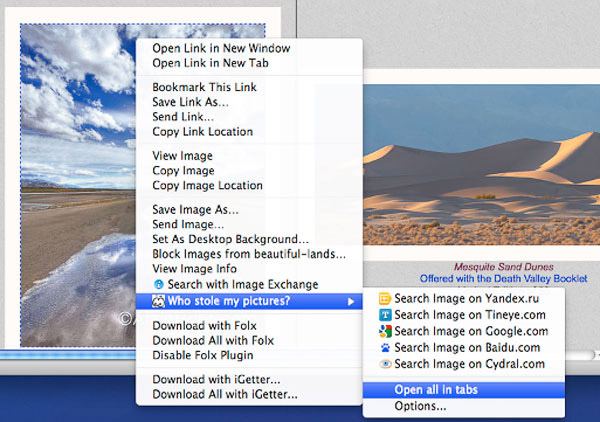
The software I use the most is the Who Stole my Pictures Firefox extension
12 - Conclusion
Unauthorized use of your photographs is not an 'if' but a 'when.' This is particularly true if you show your photographs on the web. Since showing our photographs on the web is something nearly all of us are doing, having someone download and use our work without permission is virtually inevitable.
What matters therefore is knowing what to do when this happens. Offering options and suggestions is the purpose of this essay. My recommendation is to use the solution(s) that you find the mot appropriate and satisfying for your specific needs, beliefs and values.
Comments on NPN landscape photography articles? Send them to the editor. NPN members may also log in and leave their comments below.
 Alain Briot creates fine art photographs, teaches workshops and offers DVD tutorials on composition, conversion, optimization, printing and marketing photographs. Alain is also the author of Mastering Landscape Photography. Mastering Photographic Composition, Creativity and Personal Style and Marketing Fine Art Photography. All 3 books are available from Amazon and other bookstores as well from Alains website.
Alain Briot creates fine art photographs, teaches workshops and offers DVD tutorials on composition, conversion, optimization, printing and marketing photographs. Alain is also the author of Mastering Landscape Photography. Mastering Photographic Composition, Creativity and Personal Style and Marketing Fine Art Photography. All 3 books are available from Amazon and other bookstores as well from Alains website.
You can find more information about Alain's work, writings and tutorials as well as subscribe to Alains Free Monthly Newsletter on his website at http://www.beautiful-landscape.com To subscribe simply go to http://www.beautiful-landscape.com and click on the Subscribe link at the top of the page. You will have access to over 40 free essays by Alain, in PDF format, immediately after subscribing.
Alain welcomes your comments on this essay as well as on his other essays. You can reach Alain directly by emailing him at alain@beautiful-landscape.com.